Tune Up is one of those classic up-tempo jazz standards that every player should work on. Composed by Eddie Vinson, It became super well known when legendary trumpeter player Miles Davis recorded it on his 1956 album Blue Haze. And over the years, it’s turned into a popular jam session tune that can be pretty difficult to get the hang of for aspiring jazz improvisers.
Recorded by not only Miles, but Sonny Rollins, Sonny Stitt, Chet Baker, Wes Montgomery, J.J. Johnson and more, everyone playing jazz should learn how to play a great solo on Tune Up.
So today, we’re going to do just that…
We’ll start by looking at the chord changes and the simple theory behind them.
Then we’ll break down 3 transcribed solos on Tune Up by 3 legendary musicians:
- Miles Davis
- Chet Baker
- Sonny Rollins
By the end of this lesson, you’ll have a bunch of tools to use and more than enough to get you started toward mastery of this tune.
Tune Up – Understanding The Chord Progression
Before we get into the chord changes, first have a listen to the tune from the Miles album Blue Haze…
Now the chord changes to Tune Up are fairly easy to understand because they consist of a series of simple ii V I progressions – the first 12 bars are all ii V I I in three different keys…
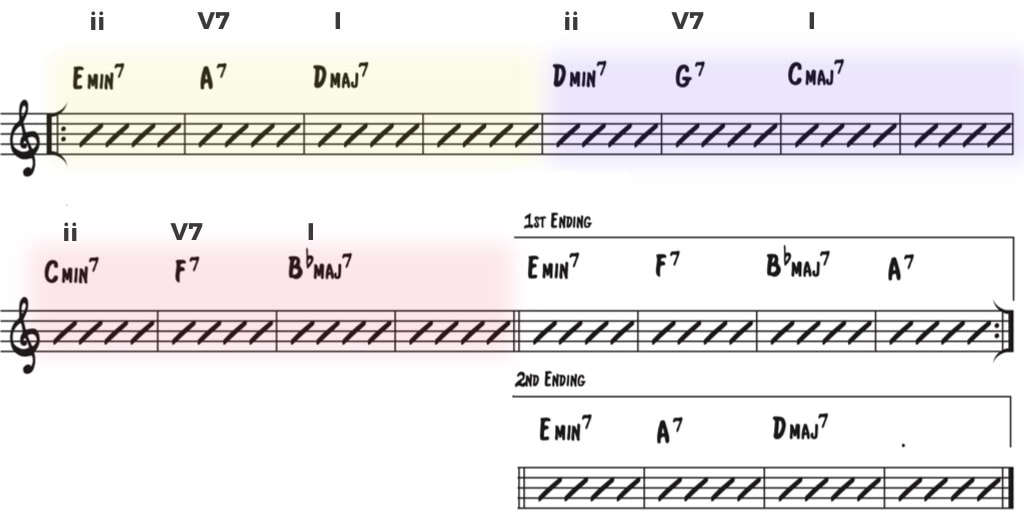
Each ii V7 I is located a whole step down from the previous…and each of the ii V Is moves to the next one by changing the quality of the I chord from major to minor – as in D major moves to D minor…
These are both very important concepts to understand about the changes…
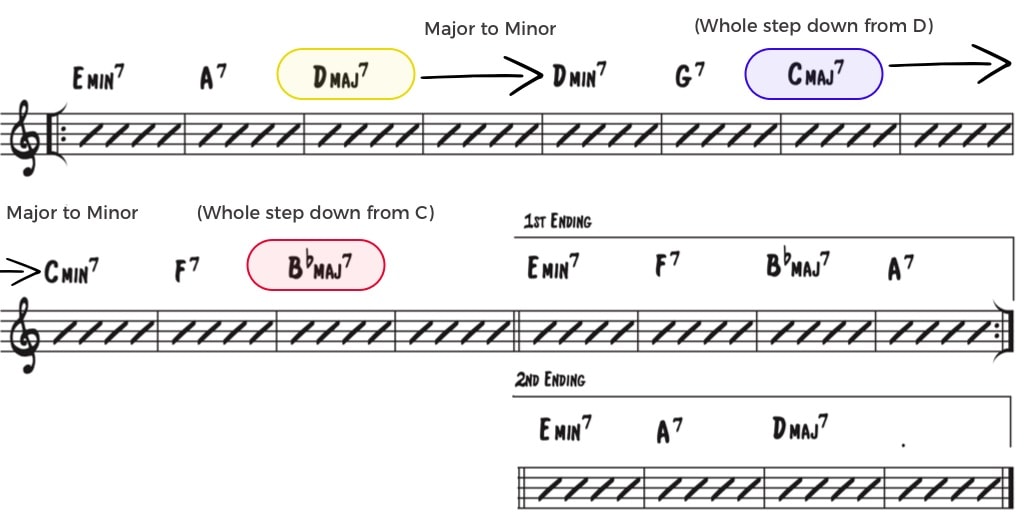
Now, in some recordings like the Chet Baker recording we’ll get into later, the 1st ending and the 2nd ending are the same – they’re simply a ii V7 I in the key of D major, the equivalent to the second ending here.
However, in many recordings like both the Miles and Sonny recordings that we’ll study today, the 1st ending uses a slight variation.
Rather than a ii V7 I in D, they use a ii chord from D, but a V7 to I from Bb, followed by the V7 from D – It’s basically a mash up between the two keys, Bb & D.
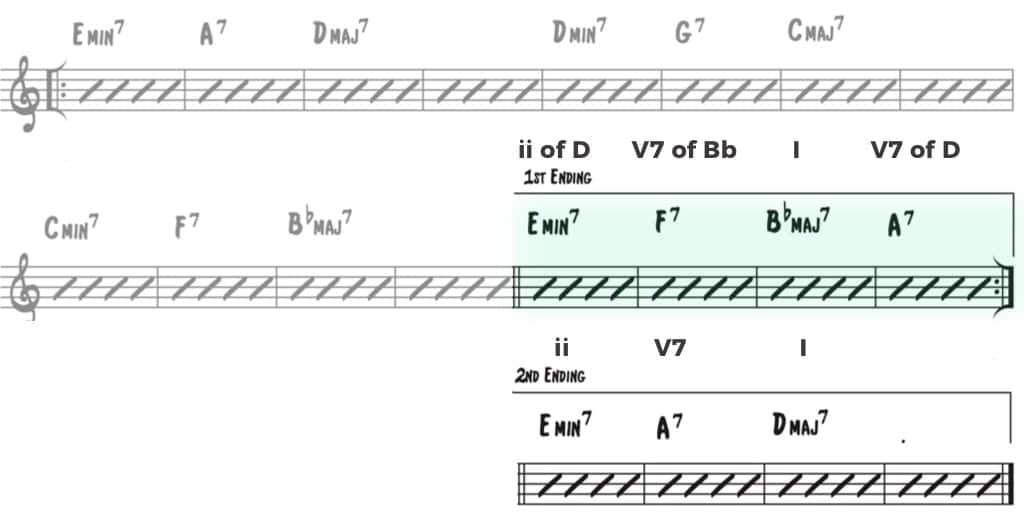
So for the most part, playing over Tune Up is an exercise in how well you can play over the ii V7 I progression moving down in whole steps at a fast tempo, which certainly poses some serious challenges…
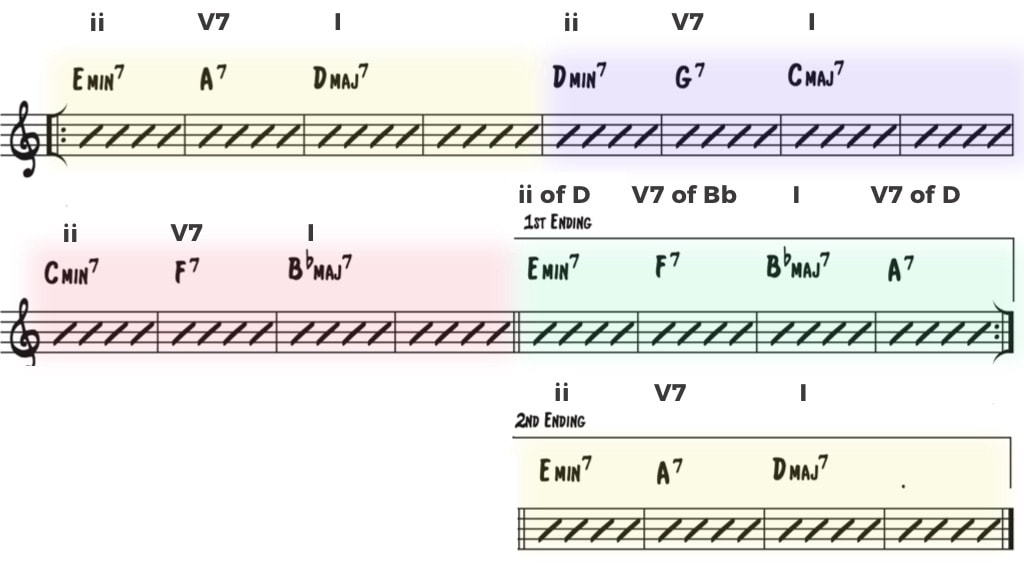
Now if all this talk of chords and chord function has you in a panic, make sure to give our Jazz Theory Course a look. It will give you a very deep understanding of how harmony works.

Okay, so once you’ve got the changes in your head, go ahead and listen to the 3 recordings of Tune Up that we’re going to break down today…
3 Transcribed Solos on Tune Up
Today we’ll look at 3 different approaches from 3 different players on Tune Up that you can learn a ton from…
The first is the classic Miles Davis version from his album Blue Haze that we already listened to earlier…
Then the next one we’ll look at is from trumpeter Chet Baker and shows quite a different approach…
And then finally, we’ll get into the intricate bebop lines of Sonny Rollins…
Each of these 3 solos has more to talk about than a single lesson could possibly hold, so we’re not going to talk about everything they’re doing.
Instead we’ll highlight 3 tools from each of the 3 players.
Here we go…
Miles Davis Plays Tune Up

Just as I always say, Miles is pure genius…
The way he phrases, how he articulates his lines, his time-feel and vibe… these kinds of things are best taken through direct imitation.
But even then, there’s so much going on here that you can take – simple tools that will make playing over Tune Up a whole lot easier.
Go ahead and listen to his whole chorus on Tune Up to get an idea about how clear his ideas really are…
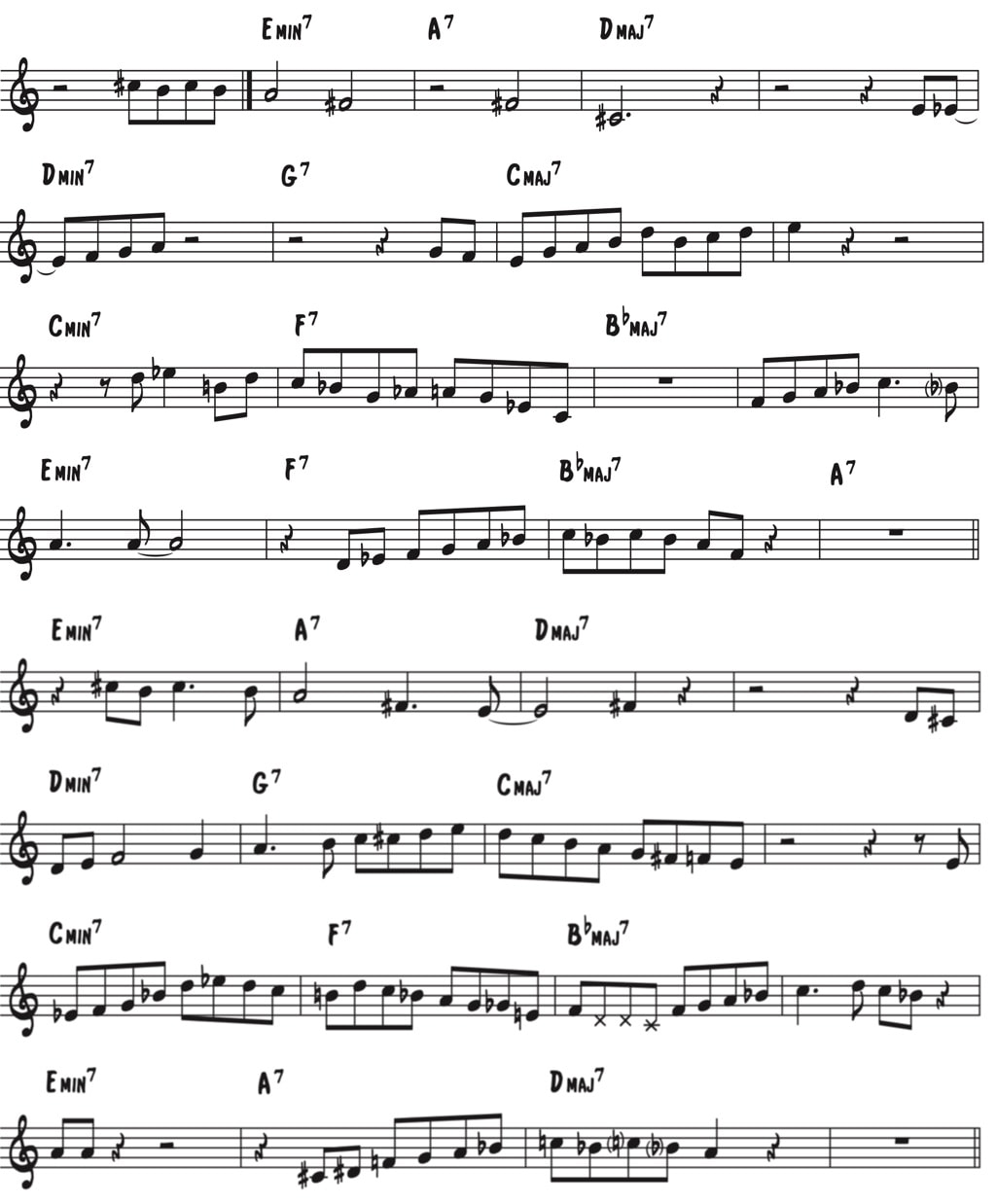
There’s a lot going on here, but we’re going to focus on 3 tools he uses that you can easily implement into your game plan on Tune Up.
Tool 1: Use Tonic Thinking and the iii Minor Pentatonic
So the first thing that stands out is how he makes such a clear opening phrase on the tune. I mean, most people would just launch into endless eighth notes, but Miles plays such a concise statement.

How does he do this so easily?
Is he thinking of the ii V7 I, or might he be approaching the progression a little differently to conjure up a line like this?
If you listen closely, he’s probably not thinking about each chord in isolation here, but rather thinking more of the Tonic Key, D major. Something more like this…

See how clear the whole line becomes when you think of it in D major?
Now, keep in mind, he’s not just running up and down a D major scale – he’s emphasizing the 3rd & 7th of the chord and making use of rhythms that contain a sense of forward motion, playing over the bar line.
But we can even go a layer deeper on this…
Rather than thinking of just D major over this, you could in fact think of F# minor pentatonic, the minor pentatonic scale that starts from the 3rd of the key.
Here I’ve renumbered the chord tones in terms of the F# minor pentatonic to show you how easy this phrase becomes when you think of this…
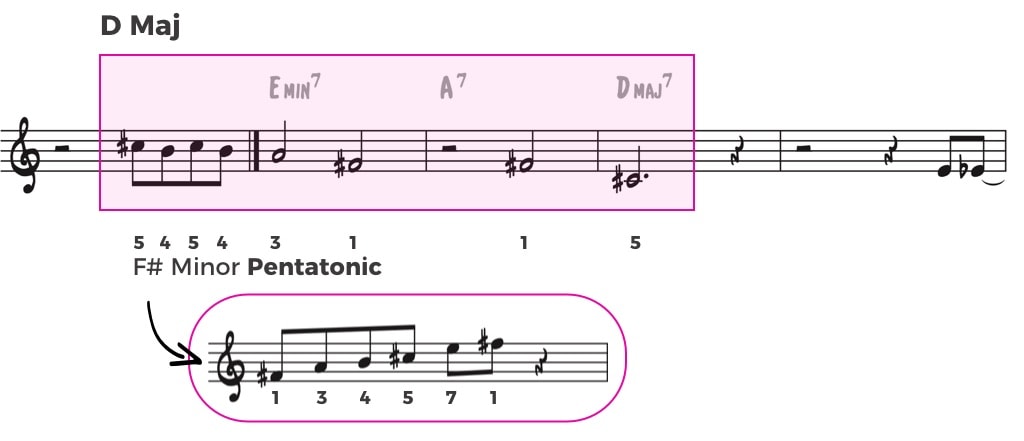
This little melodic trick makes it even easier to access the type of statement that Miles is playing.
Now what’s really interesting is how Miles opens his second chorus…

Can you hear it?
He’s using the exact same technique, thinking of the Tonic, D major, or using the minor pentatonic from the 3rd, F# minor pentatonic.
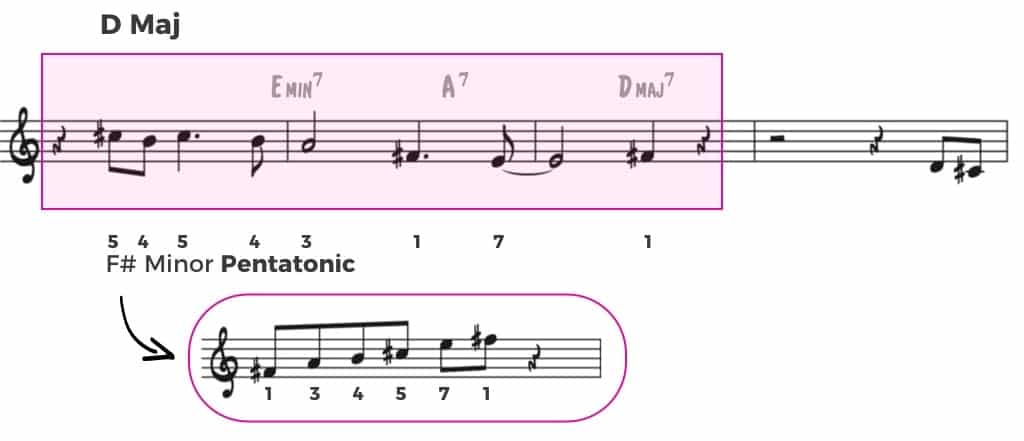
You can think of the Tonic or the minor iii pentatonic here, or anything else that helps you conceptualize this statement…
But make sure to always take note when a player uses something more than once within their solo – it means they especially like the technique and spent time on it in the practice room, so it’s something that you might want to spend time on, too.
Tool 2: Acquire Simple Jazz Language
When you’re playing fast tempos in jazz, there’s very little time to think. So having some stock phrases that you can rely on to help you hear and play over the changes becomes extra important.
This is called Jazz Language, and it bridges the gap between understanding chords intellectually, and actually playing on them.
And looking at this solo, it’s clear that Miles worked on some simple jazz language to help him get through these changes.
First he had some simple major language that he could easily access in all keys…Ideas like this…

And this…

And then some simple minor language…

And of course, some simple dominant language like this on F7…

Or this…

These types of lines are the Building Blocks of your solo and without some solid jazz language and an understanding of how to use it, playing ii V7 Is at a faster tempo is going to pose quite the challenge.
For more on jazz language, make sure to check out our Jazz Language Course Melodic Power.

We built this course specifically to solve the problem of acquiring useful jazz language and understanding how to actually improvise with it, which is absolutely crucial when you’re approaching a tune like Tune Up.
Tool 3: Delay The V7 Resolution
One final tool will look at from Miles will help your lines sound less boxy and make them more interesting…
You see, when most people play over ii V7 Is, they approach each chord individually and give too much respect to the bar lines…

But sonny Rollins likes to delay his resolution by extending it over into the major bars.

Take at a listen to this line and try to hear him using this tool near the end of the chorus…

Applying an A7 Altered scale, he adds quite a bit of tension to the V7 chord, and rather than resolving the A7 to D major right at the bar line, he continues to play the A7 alt sound into the D major bar.

Notice that he doesn’t resolve the tension until beat 3 of the D major bar. This is a subtle yet very useful technique that you should be sure to learn – it will give you a whole lot more freedom on ii V7 Is.
Okay, so at this point you’ve got 3 great tools from Miles Davis over Tune Up, so now we’ll move onto our next solo…
Chet Baker Plays Tune Up
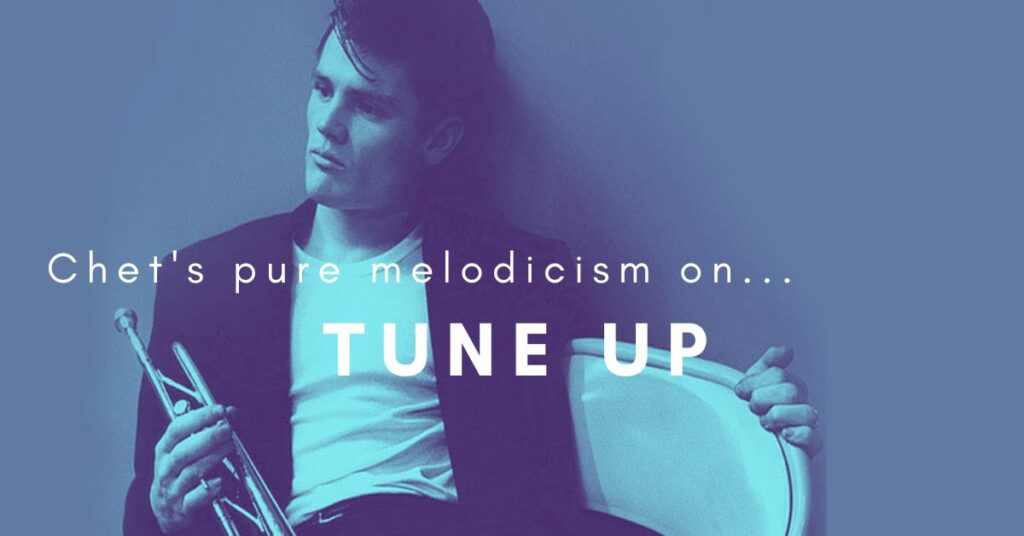
Now that you’ve got an idea about how Miles approaches Tune Up, let’s take a look into how Chet Baker constructs lines over it…
Take a listen to his solo…
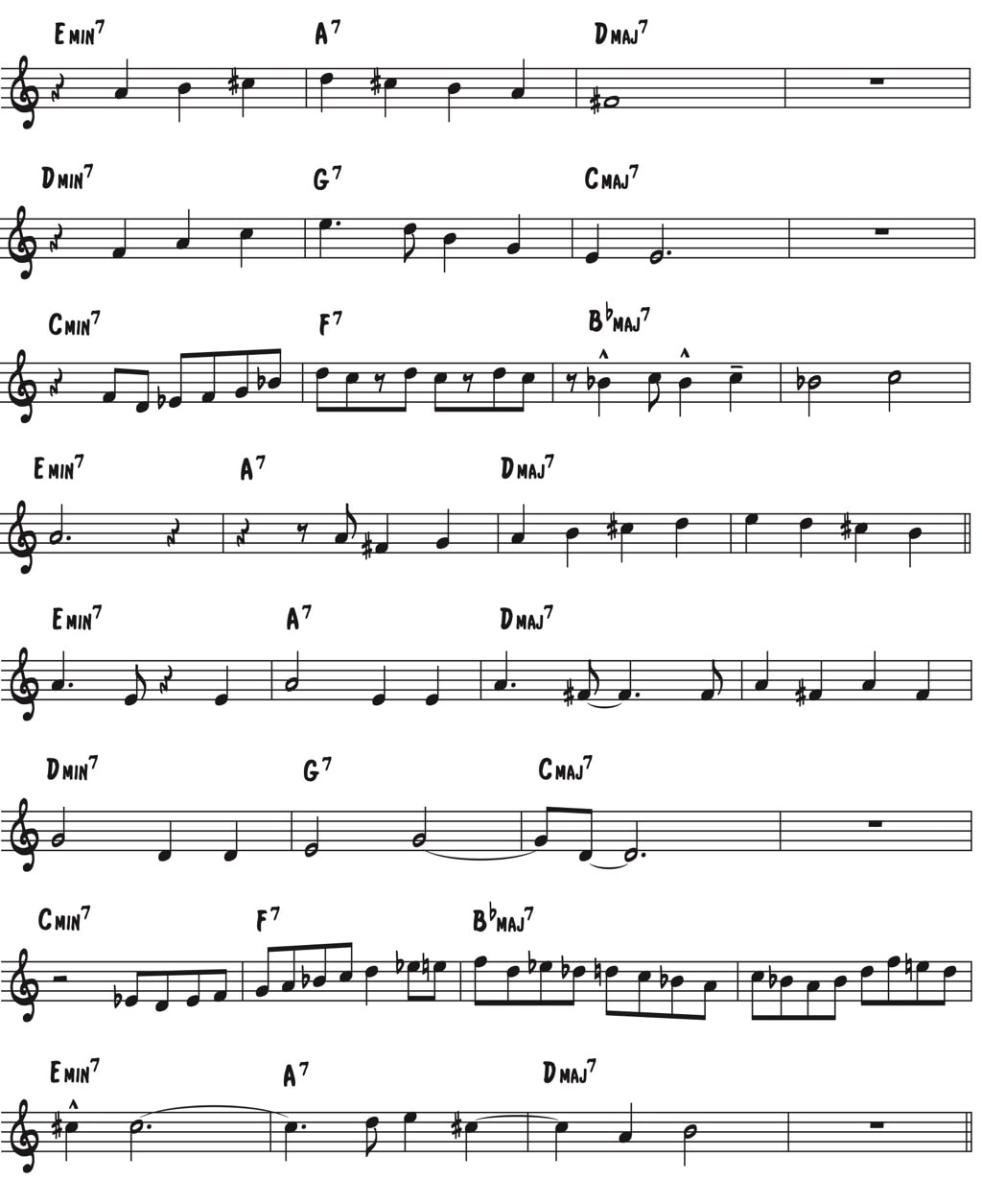
While some of what he plays is similar to Miles, many of the tools from his solo are based more upon larger note values, primarily quarter notes.
And melodically, he’s thinking a bit simpler, which in-turn makes some great exercises for you to practice.
Tool 1: Tonic Key Thinking
Like Miles, Chet seems to be thinking of the the tonic key over the whole ii V7 I at points. For instance, take his opening line…

It’s essentially an excerpt straight from a D major scale. But, he utilizes rhythms that push forward, and makes sure to place the chord-tones he wants to aim for on the strong beats.
So it’s not quite as simple as it appears to be…

To practice this, simply take this line through all keys moving down in whole steps…
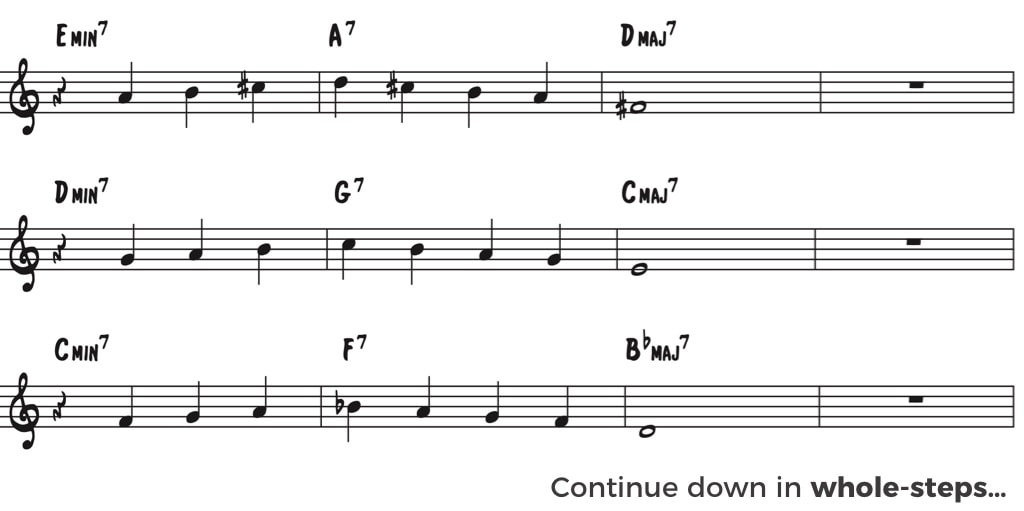
This exercise will greatly help you master the Tune Up chord progression and get you comfortable playing over it.
Tool 2: Play the ii V7 with simple arpeggios and triads
Now in this next line, Chet thinks of each chord within the ii V7 I, but plays a very simple mix of an arpeggio and a triad.

He moves up the D minor chord to the 9th, which becomes the 13th of the V7 chord, and then comes down the triad of the V7 chord.

Like the first line, this is actually a great exercise to practice in descending whole steps.
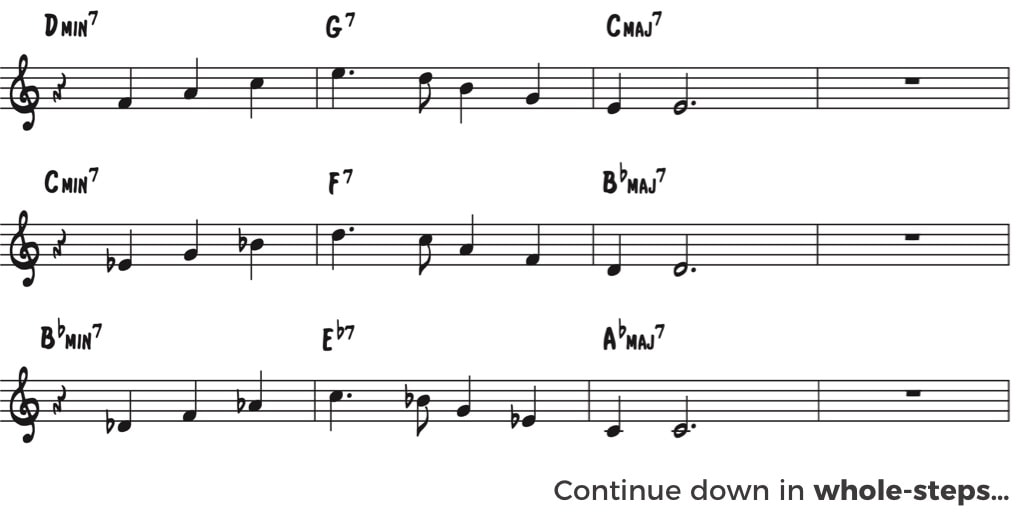
Between this and the last exercise, you’ll easily create a solid foundation over the ii V7 I progression that you can then build upon. Don’t ignore them, or think they’re too easy – they’re extremely worthwhile.
Tool 3: Think of V7 over the whole ii V7
And one more tool from Chet…take a listen to this line here…

Rather than thinking of ii V7, in this case E- A7 and D- G7, he simplifies his approach and just thinks of the V7 chord.
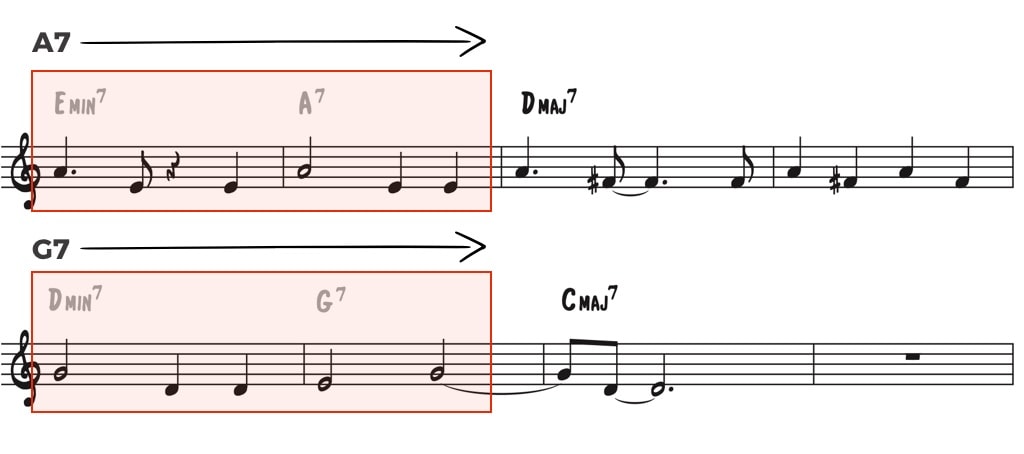
This is a great technique that he loves to use and make melodic motifs from, and he does so by playing around with the chord-tones of the A7 chord, 1 and 5.

While it looks easy, to play lines like this takes years of study and practice.
Think of Chet Baker’s style as something that’s highly refined, where everything unnecessary is removed.
This is quite difficult to achieve in a solo, but all of these Chet lines make great exercises for you to work on. So try taking them through all keys, and you’ll see a lot of improvement on this progression.
Sonny Rollins Plays Tune Up
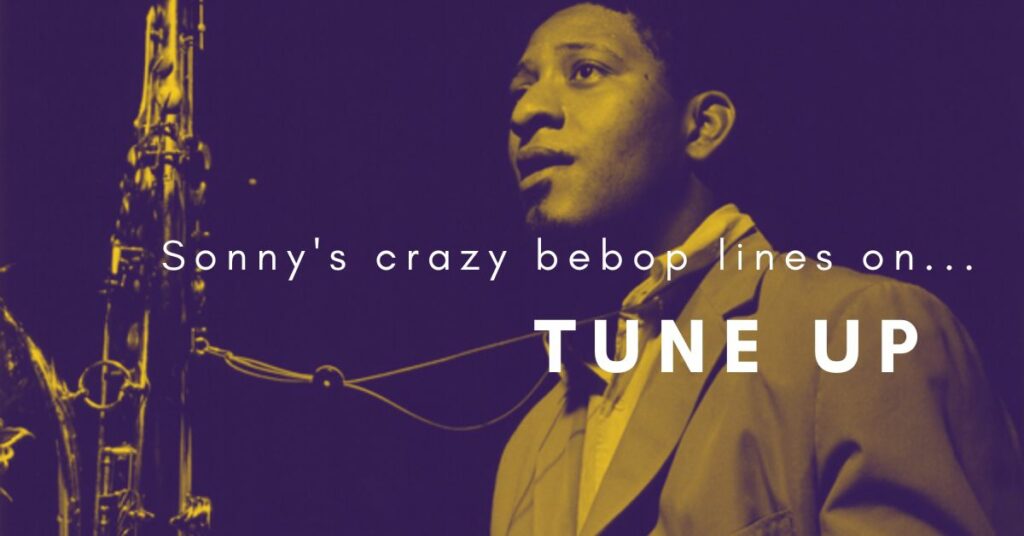
Alright, we’ve looked at 2 beautiful solos on Tune Up, and now we’ll quickly look at a third take on the changes played by tenor saxophonist Sonny Rollins.
This solo is screaming fast and Sonny plays a whole collection of amazing bebop lines…
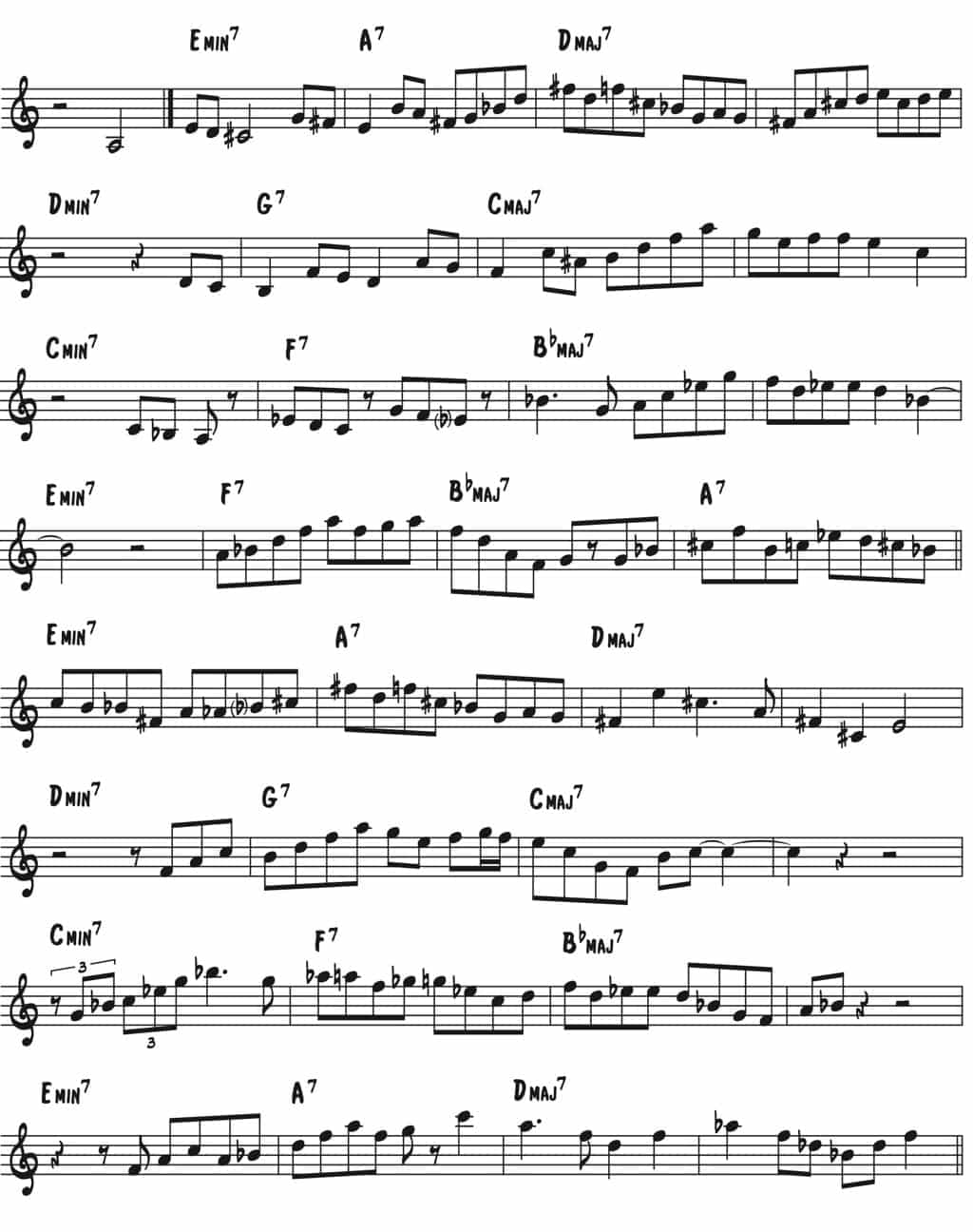
Okay, let’s break this solo down and learn some classic Sonny Rollins improvisation tools that you can quickly add to your concept.
Tool 1: Use motifs as a jumping off point
Sonny Rollins is known for motivic development – taking a small defined melodic unit, a motif, and using it as a springboard for his own creativity.
He’ll often take just two or three notes and use them to create a full eight or sixteen bars of a solo.
Have a listen to this passage and try to hear his use of motivic development.
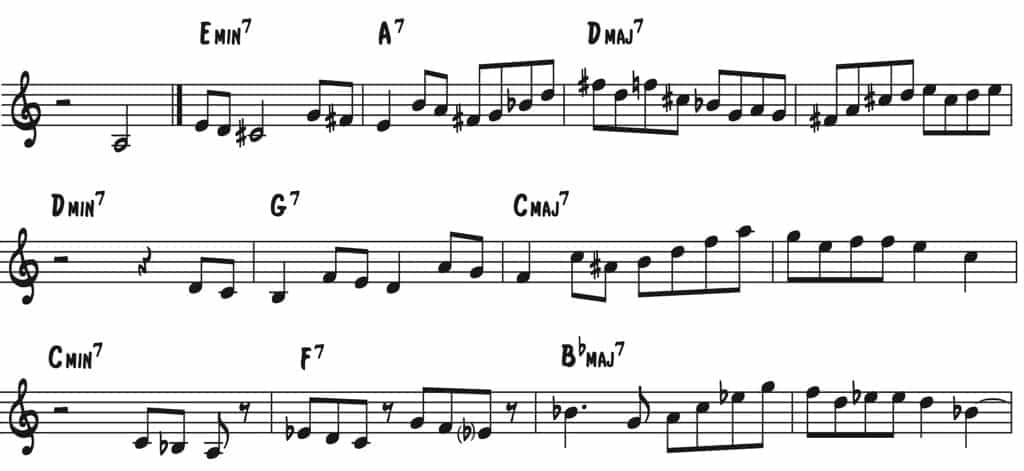
Can you spot the motif? – It’s all about the melodic shape, rhythm, and direction of these 3 notes.

This motif is used as a jumping off point for this entire passage, in fact he uses it with slight variation 10 times in this section…
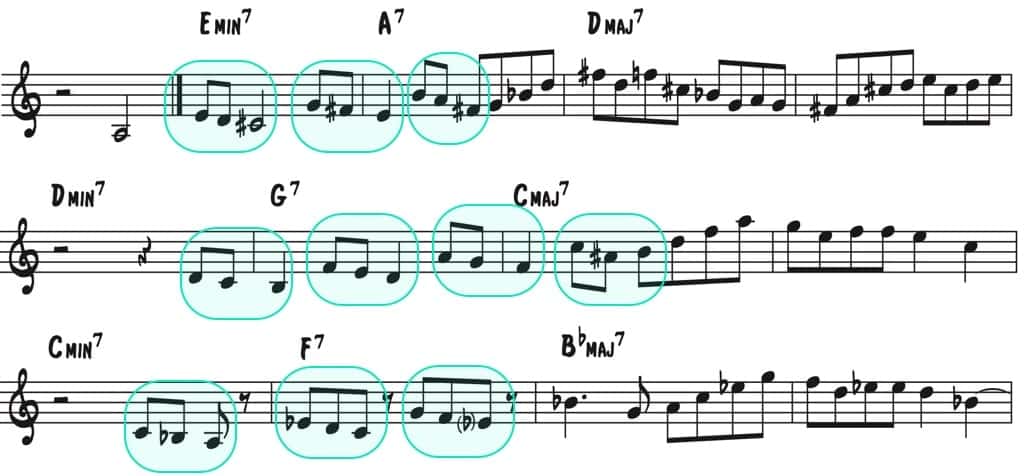
Learning to apply this soloing tactic is not easy, but it’s something to be aware of.
Take a small defined melodic unit, a motif, and work on developing it and using it as the basis for a longer line.
Tool 2: Anticipate the tonic with major language
So we talked about delaying the resolution of the V7 chord like this….

But you could also do the opposite – you could anticipate the resolution, which as you’ll see in a moment, Sonny does on the 1st ending changes…

Have a listen to this line here…

What Sonny does in this particular place is play major language over the V7 chord, effectively anticipating the resolution of the Bb major chord, the I.

At a fast tempo, this technique can be extremely useful as it allows you to think of only the major chord and simply play major language, so it’s a good one to have at your disposal when things speed up.
Tool 3: Use quintessential Sonny Rollins language
When you study any player, they’re bound to have jazz language that is unique to their particular style. John Coltrane has his language, Sonny Stitt has his, Clifford Brown is a great example…
Every great player has lines that are very much them.
And this highlighted piece of the line that you’re about to hear is very much Sonny Rollins…

He loves this phrase and it comes up all the time in his playing, and while you might just think it’s major language, it’s not quite that straightforward.
If you listen closely, you’ll hear that the first part of it has more tension, and that it sounds as though it resolves near the end, and that’s because he’s really implying V7 to I motion here, G7 to C…

Now, if we look at the whole part of the solo that we transcribed, he actually uses this melodic fragment 4 times in almost the same way!
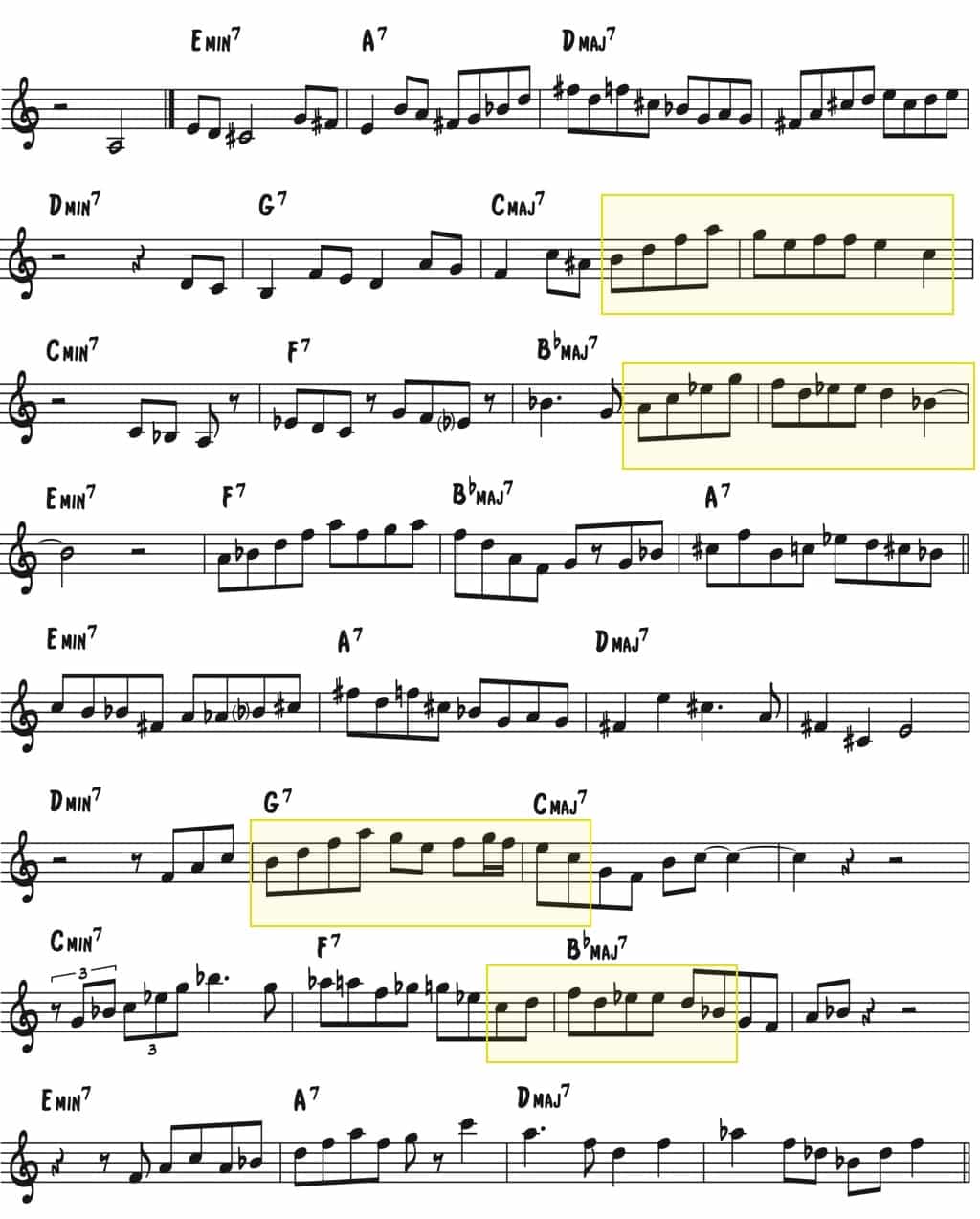
And the 3rd time he uses it gives us the insight we need to confirm how he’s thinking about this – you can see that he’s using it over V7 to I, G7 to C, rather than just over the major part.

Indeed, this is a V7 to I line and he just loves it so much that he’s found ways to use it any way that he possibly can.
This is a great line to steal – make it your own and study the underlying concepts to absorb the magnificent Sonny Rollins style into your own playing.
Learning to solo on Tune Up
With everything we went over today, Tune Up should be a whole lot clearer. You should now know…
- How to conceptualize the Tune Up chord changes
- How to use Tonic thinking over a full ii V7 I
- How to apply the iii minor pentatonic scale
- The necessary jazz language you should be working on
- How to delay and anticipate the V7 resolution
- Some basic exercises from Chet Baker to master ii Vs
- How to approach ii V7s using just the V7 chord
- How to use motifs as a jumping off point
Within these 3 solos, there is so much information!
Remember, don’t try to tackle everything at once – it took these players years and years of study to get to the point where they could produce a solo like this.
Take a single line, concept, or exercise we went over today and take it to the practice room.
Work on it for a solid week every single day and Tune Up will get easier and easier. And when it does, everything else will too because the exact same progression shows up everywhere!










